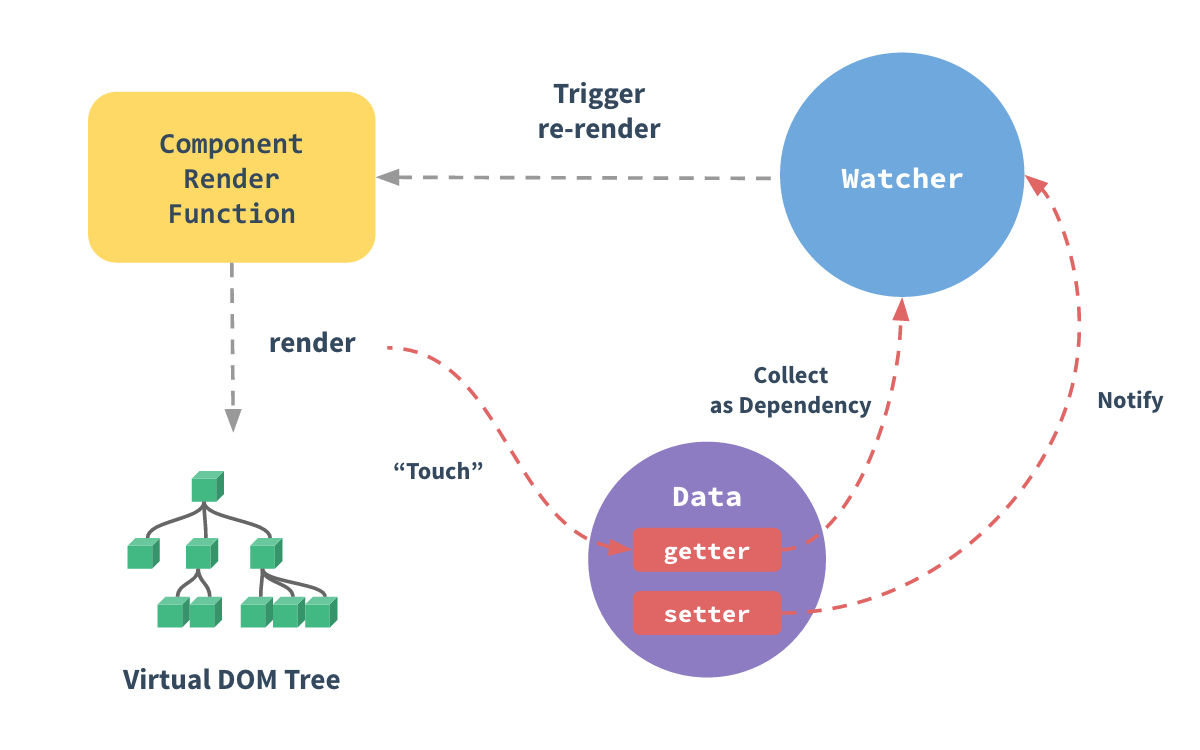Vue.js一个核心特性就是响应式数据,Vue会把普通对象变换成响应式对象,其中核心逻辑就是依赖收集。

defineReactive
Vue.js中将普通对象转换为响应式对象的核心代码如下:
function defineReactive$$1 (
obj,
key,
val,
customSetter,
shallow
) {
var dep = new Dep();
var property = Object.getOwnPropertyDescriptor(obj, key);
if (property && property.configurable === false) {
return
}
// cater for pre-defined getter/setters
var getter = property && property.get;
var setter = property && property.set;
if ((!getter || setter) && arguments.length === 2) {
val = obj[key];
}
var childOb = !shallow && observe(val);
Object.defineProperty(obj, key, {
enumerable: true,
configurable: true,
get: function reactiveGetter () {
var value = getter ? getter.call(obj) : val;
if (Dep.target) {
dep.depend();
if (childOb) {
childOb.dep.depend();
if (Array.isArray(value)) {
dependArray(value);
}
}
}
return value
},
set: function reactiveSetter (newVal) {
var value = getter ? getter.call(obj) : val;
/* eslint-disable no-self-compare */
if (newVal === value || (newVal !== newVal && value !== value)) {
return
}
/* eslint-enable no-self-compare */
if (customSetter) {
customSetter();
}
// #7981: for accessor properties without setter
if (getter && !setter) { return }
if (setter) {
setter.call(obj, newVal);
} else {
val = newVal;
}
childOb = !shallow && observe(newVal);
dep.notify();
}
});
}
复制代码这段代码需要关注的有如下几点:
1. Object.defineProperty(obj, prop, descriptor)
复制代码该方法能够直接修改一个对象的属性或者添加一个属性,并返回这个对象。其中需要关注的是get和set方法,如果我们修改某个对象的值就会触发setter方法,如果访问某个对象的值就会触发getter方法。
2. var dep = new Dep();
复制代码Dep构造函数是整个vue依赖收集的核心,定义一个响应式数据的时候就会创建一个Dep实例,访问该对象属性的时候会触发dep.depend(),修改该对象属性的时候会触发dep.notify(),这个就像订阅模式,当被订阅者属性发生变化的时候就会进行广播,告诉订阅者数据发生了变化
vm.set(target, key, val)
说到这,我们知道在vue.js中动态添加对象属性不是响应式的,因为动态添加的属性不在new Vue()的初始化中,需要通过vm.$set(target,property,valye)来动态添加。我们来看下vm.$set是如何实现的。
function set (target, key, val) {
if (isUndef(target) || isPrimitive(target)
) {
warn(("Cannot set reactive property on undefined, null, or primitive value: " + ((target))));
}
if (Array.isArray(target) && isValidArrayIndex(key)) {
target.length = Math.max(target.length, key);
target.splice(key, 1, val);
return val
}
if (key in target && !(key in Object.prototype)) {
target[key] = val;
return val
}
var ob = (target).__ob__;
if (target._isVue || (ob && ob.vmCount)) {
warn(
'Avoid adding reactive properties to a Vue instance or its root $data ' +
'at runtime - declare it upfront in the data option.'
);
return val
}
if (!ob) {
target[key] = val;
return val
}
defineReactive$$1(ob.value, key, val);
ob.dep.notify();
return val
}
复制代码其中判断了是否为数组,如果是数组就通过splice方法更新。set()方法的核心在下面两句:
defineReactive$$1(ob.value, key, val);
ob.dep.notify();
复制代码本质上还是调用defineReactive$$1方法将当前属性设置为响应式。
Dep
Dep 是整个 getter 依赖收集的核心。
var uid = 0;
/**
* A dep is an observable that can have multiple
* directives subscribing to it.
*/
var Dep = function Dep () {
this.id = uid++;
this.subs = [];
};
Dep.prototype.addSub = function addSub (sub) {
this.subs.push(sub);
};
Dep.prototype.removeSub = function removeSub (sub) {
remove(this.subs, sub);
};
Dep.prototype.depend = function depend () {
if (Dep.target) {
Dep.target.addDep(this);
}
};
Dep.prototype.notify = function notify () {
// stabilize the subscriber list first
var subs = this.subs.slice();
if (!config.async) {
// subs aren't sorted in scheduler if not running async
// we need to sort them now to make sure they fire in correct
// order
subs.sort(function (a, b) { return a.id - b.id; });
}
for (var i = 0, l = subs.length; i < l; i++) {
subs[i].update();
}
};
// The current target watcher being evaluated.
// This is globally unique because only one watcher
// can be evaluated at a time.
Dep.target = null;
var targetStack = [];
function pushTarget (target) {
targetStack.push(target);
Dep.target = target;
}
function popTarget () {
targetStack.pop();
Dep.target = targetStack[targetStack.length - 1];
}
复制代码Dep是一个构造函数,在其原型上分别定义了addSub,removeSub,depend,notify方法。需要特别注意的是它的一个属性target。pushTarget方法可以设置target值。通过之前代码分析我们知道将普通对象转为响应式对象,有段非常重要的代码是:
var dep=new Dep();
...
dep.notify();
...
dep.depend();
复制代码我们看它们的实现:
Dep.prototype.depend = function depend () {
if (Dep.target) {
Dep.target.addDep(this);
}
};
Dep.prototype.notify = function notify () {
// stabilize the subscriber list first
var subs = this.subs.slice();
if (!config.async) {
// subs aren't sorted in scheduler if not running async
// we need to sort them now to make sure they fire in correct
// order
subs.sort(function (a, b) { return a.id - b.id; });
}
for (var i = 0, l = subs.length; i < l; i++) {
subs[i].update();
}
};
复制代码depend()方法实际上就是Dep的target属性添加当前对象。而notify()方法是执行subs数组中的方法的update。那么这个target到底是谁?我们看pushTarget()方法在哪调用的 。
Watcher.prototype.get = function get () {
pushTarget(this);//看这里
...
};
复制代码也就是说,构造函数Dep的target是指向Watcher构造函数的。
Watcher
var Watcher = function Watcher (
vm,
expOrFn,
cb,
options,
isRenderWatcher
) {
this.vm = vm;
if (isRenderWatcher) {
vm._watcher = this;
}
vm._watchers.push(this);
// options
if (options) {
this.deep = !!options.deep;
this.user = !!options.user;
this.lazy = !!options.lazy;
this.sync = !!options.sync;
this.before = options.before;
} else {
this.deep = this.user = this.lazy = this.sync = false;
}
this.cb = cb;
this.id = ++uid$2; // uid for batching
this.active = true;
this.dirty = this.lazy; // for lazy watchers
this.deps = [];
this.newDeps = [];
this.depIds = new _Set();
this.newDepIds = new _Set();
this.expression = expOrFn.toString();
// parse expression for getter
if (typeof expOrFn === 'function') {
this.getter = expOrFn;
} else {
this.getter = parsePath(expOrFn);
if (!this.getter) {
this.getter = noop;
warn(
"Failed watching path: \"" + expOrFn + "\" " +
'Watcher only accepts simple dot-delimited paths. ' +
'For full control, use a function instead.',
vm
);
}
}
this.value = this.lazy
? undefined
: this.get();
};
/**
* Evaluate the getter, and re-collect dependencies.
*/
Watcher.prototype.get = function get () {
pushTarget(this);
var value;
var vm = this.vm;
try {
value = this.getter.call(vm, vm);
} catch (e) {
if (this.user) {
handleError(e, vm, ("getter for watcher \"" + (this.expression) + "\""));
} else {
throw e
}
} finally {
// "touch" every property so they are all tracked as
// dependencies for deep watching
if (this.deep) {
traverse(value);
}
popTarget();
this.cleanupDeps();
}
return value
};
/**
* Add a dependency to this directive.
*/
Watcher.prototype.addDep = function addDep (dep) {
var id = dep.id;
if (!this.newDepIds.has(id)) {
this.newDepIds.add(id);
this.newDeps.push(dep);
if (!this.depIds.has(id)) {
dep.addSub(this);
}
}
};
/**
* Clean up for dependency collection.
*/
Watcher.prototype.cleanupDeps = function cleanupDeps () {
var i = this.deps.length;
while (i--) {
var dep = this.deps[i];
if (!this.newDepIds.has(dep.id)) {
dep.removeSub(this);
}
}
var tmp = this.depIds;
this.depIds = this.newDepIds;
this.newDepIds = tmp;
this.newDepIds.clear();
tmp = this.deps;
this.deps = this.newDeps;
this.newDeps = tmp;
this.newDeps.length = 0;
};
/**
* Subscriber interface.
* Will be called when a dependency changes.
*/
Watcher.prototype.update = function update () {
/* istanbul ignore else */
if (this.lazy) {
this.dirty = true;
} else if (this.sync) {
this.run();
} else {
queueWatcher(this);
}
};
/**
* Scheduler job interface.
* Will be called by the scheduler.
*/
Watcher.prototype.run = function run () {
if (this.active) {
var value = this.get();
if (
value !== this.value ||
// Deep watchers and watchers on Object/Arrays should fire even
// when the value is the same, because the value may
// have mutated.
isObject(value) ||
this.deep
) {
// set new value
var oldValue = this.value;
this.value = value;
if (this.user) {
try {
this.cb.call(this.vm, value, oldValue);
} catch (e) {
handleError(e, this.vm, ("callback for watcher \"" + (this.expression) + "\""));
}
} else {
this.cb.call(this.vm, value, oldValue);
}
}
}
};
/**
* Evaluate the value of the watcher.
* This only gets called for lazy watchers.
*/
Watcher.prototype.evaluate = function evaluate () {
this.value = this.get();
this.dirty = false;
};
/**
* Depend on all deps collected by this watcher.
*/
Watcher.prototype.depend = function depend () {
var i = this.deps.length;
while (i--) {
this.deps[i].depend();
}
};
/**
* Remove self from all dependencies' subscriber list.
*/
Watcher.prototype.teardown = function teardown () {
if (this.active) {
// remove self from vm's watcher list
// this is a somewhat expensive operation so we skip it
// if the vm is being destroyed.
if (!this.vm._isBeingDestroyed) {
remove(this.vm._watchers, this);
}
var i = this.deps.length;
while (i--) {
this.deps[i].removeSub(this);
}
this.active = false;
}
};
复制代码从文章最开始的那张图可以看出,Watcher是连接Data和Component的桥梁,它就像一双眼睛监视数据的变化,一旦数据发生变化,就会通知Component的更新,而连接Data和Watcher之间的桥梁就是上面提到的Dep。
什么时候开始watch
Watcher的实例化有三处地方:initComputed(),stateMixin(),mountComponent(),而这三处地方分别是初始化computed数据,Mixin和挂载component
Watcher做了什么
1. Watcher.prototype.get(),将当前的的watcher赋值给Dep.target,执行this.getter.call(vm, vm),每次触发的时候都会清除掉所有依赖收集,避免重复订阅。
Watcher.prototype.get = function get () {
pushTarget(this);
var value;
var vm = this.vm;
try {
value = this.getter.call(vm, vm);
} catch (e) {
if (this.user) {
handleError(e, vm, ("getter for watcher \"" + (this.expression) + "\""));
} else {
throw e
}
} finally {
// "touch" every property so they are all tracked as
// dependencies for deep watching
if (this.deep) {
traverse(value);
}
popTarget();
this.cleanupDeps();
}
return value
};
复制代码2. Watcher.prototype.addDep(),添加依赖。访问响应式对象都会执行defineProperty中的get()方法,而get()方法核心就是向Dep中添加依赖。
Watcher.prototype.addDep = function addDep (dep) {
var id = dep.id;
if (!this.newDepIds.has(id)) {
this.newDepIds.add(id);
this.newDeps.push(dep);
if (!this.depIds.has(id)) {
dep.addSub(this);
}
}
};
复制代码3. Watcher.prototype.cleanupDeps(),清除依赖
Watcher.prototype.cleanupDeps = function cleanupDeps () {
var i = this.deps.length;
while (i--) {
var dep = this.deps[i];
if (!this.newDepIds.has(dep.id)) {
dep.removeSub(this);
}
}
var tmp = this.depIds;
this.depIds = this.newDepIds;
this.newDepIds = tmp;
this.newDepIds.clear();
tmp = this.deps;
this.deps = this.newDeps;
this.newDeps = tmp;
this.newDeps.length = 0;
};
复制代码4. Watcher.prototype.update(),更新数据
Watcher.prototype.update = function update () {
/* istanbul ignore else */
if (this.lazy) {
this.dirty = true;
} else if (this.sync) {
this.run();
} else {
queueWatcher(this);
}
};
复制代码我们有时候需要强制更新数据,会用到$forceUpdate()方法,而这个方法实际上就调用的watcher.update();
Vue.prototype.$forceUpdate = function () {
var vm = this;
if (vm._watcher) {
vm._watcher.update();
}
};
复制代码细心点的会发现Watcher.prototype.update()最后一行代码是queueWatcher(this);,也就是Watcher的更新不是同步的,而是一个队列。这也是我们为什么有时候改数据,视图不会立马更新或者不能及时拿到最新数据的原因。
小结:
-
- 普通对象转为响应式对象核心方法是defineProperty,获取属性值的时候会触发
dep.depend();收集依赖,修改值的时候会触发 dep.notify(),通知变化。
- 普通对象转为响应式对象核心方法是defineProperty,获取属性值的时候会触发
-
- 收集依赖的核心是Dep构造函数,实际上利用的是订阅模式,添加订阅者,数据发生变化通知订阅者。
-
- Watcher的作用是访问数据向Dep中添加依赖,修改数据时通知变化,同时通过回调通知更新视图。
-
- Watcher更新的时候是更新watcher队列,所以数据及视图的更新是异步的。




